Delta Electronics orporated PH8-P GSM/GPRS/UMTS/HSPA Module User Manual 5 Swich
Delta Electronics Incorporated GSM/GPRS/UMTS/HSPA Module 5 Swich
User Manual
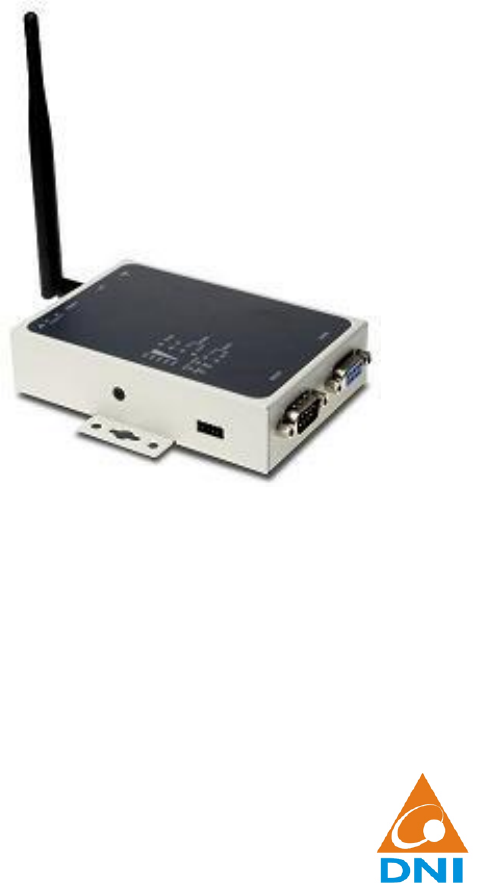
DNI Smart Grid Data Collector
SGDC-D22 User Manual
Rev. 1.9
2017/01/19
Notice:
1. Delta Networks Inc. reserves the right to change specifications detailed in this document at any time without notice, and assumes no
responsibility for any errors within this document.
2. This document contains proprietary technical information in which is the property of the Delta Networks Inc. and shall not be disclosed
to others in whole or in part, reproduced, copied, or used as the basis for design, manufacturing, or sale of apparatus without written
permission of Delta Networks Inc.

Doc #: 1ANSU-160004
DNI SGDC-D22 User Manual
i. i
Table of Contents
1. Introduction ............................................................................................................................................................ 1
1.1. GENERAL DESCRIPTION ................................................................................................................................................... 1
1.2. TARGET APPLICATIONS .................................................................................................................................................... 1
1.3. PRODUCT INFORMATION .................................................................................................................................................. 1
1.4. REGULATION DECLARATION ............................................................................................................................................. 2
2. Platform Description ............................................................................................................................................... 3
2.1. HARDWARE INFORMATION ............................................................................................................................................... 3
2.2. SOFTWARE INFORMATION ................................................................................................................................................ 5
3. Tool Chain Installation ............................................................................................................................................ 7
3.1. ENVIRONMENT................................................................................................................................................................. 7
3.2. INSTALLING STLINUX ON UBUNTU .................................................................................................................................. 7
3.3. ADD TOOL CHAIN PATH ................................................................................................................................................... 8
4. Getting Started ........................................................................................................................................................ 9
4.1. CONNECT TO PC .............................................................................................................................................................. 9
4.2. SIM CARD AND SD CARD INSTALLATION .......................................................................................................................11
4.3. LOGIN DATA COLLECTOR ............................................................................................................................................... 12
5. The First Program ................................................................................................................................................. 14
5.1. COMPILE HELLOWORLD.C .............................................................................................................................................. 14
5.2. SEND FILES TO DATA COLLECTOR .................................................................................................................................. 14
5.3. EXECUTE PROGRAM AT DATA COLLECTOR ..................................................................................................................... 14
6. Communication Settings ........................................................................................................................................ 15
6.1. STATIC IP ON ETH0 ......................................................................................................................................................... 15
6.2. DHCPD AND DHCP CLIENT ......................................................................................................................................... 15
6.3. 3G ................................................................................................................................................................................. 16
6.4. PPPOE OVER ETH0 ......................................................................................................................................................... 17
7. Daemons & Utilities............................................................................................................................................... 20
7.1. RAMDISK ....................................................................................................................................................................... 20
7.2. NFS (NETWORK FILE SYSTEM) ..................................................................................................................................... 21
7.3. TELNET & SSH SERVICE ................................................................................................................................................ 22

Doc #: 1ANSU-160004
DNI SGDC-D22 User Manual
i. ii
7.4. FTP & SCP .................................................................................................................................................................... 24
7.5. HTTP ............................................................................................................................................................................ 25
7.6. NTP & RTC ................................................................................................................................................................... 27
7.7. SSL ............................................................................................................................................................................... 28
7.8. SENDMAIL VIA SMTP .................................................................................................................................................... 29
8. I/O Control ............................................................................................................................................................ 30
8.1. DATA COLLECTOR ID ..................................................................................................................................................... 30
8.2. SYSTEM READY LED ..................................................................................................................................................... 30
8.3. BUZZER ......................................................................................................................................................................... 30
8.4. RESET BUTTON .............................................................................................................................................................. 30
8.5. RS-232 & RS-485 ......................................................................................................................................................... 30
8.6. SD CARD ....................................................................................................................................................................... 31
8.7. COMBINE WDT INTO YOUR PROGRAM .......................................................................................................................... 31
9. Linux Kernel Upgrade & Backup .......................................................................................................................... 33
10. Reference .............................................................................................................................................................. 35

Doc #: 1ANSU-160004
DNI SGDC-D22 User Manual
i. iii
Revision History
Version
Date
Author
Description
1.0
2012/5/9
DNI SG Team
Initial Release.
1.1
2012/5/23
DNI SG Team
Add Linux Kernel Upgrade & Backup section.
1.2
2012/6/4
DNI SG Team
Add & modify sections below
- Communication Settings
- Daemons & Utilities
- I/O Control
1.3
2012/10/12
DNI SG Team
Modify some configurations.
1.4
2013/11/29
DNI SG Team
Add SIM & SD card installation.
1.5
2014/4/29
DNI SG Team
Add ZigBee feature for SGDC-D23.
1.6
2014/11/4
DNI SG Team
Add SGDC-D24.
1.7
2016/9/2
Jacky Lai
Update to standard format
Remove 2G(GPRS) for certification
1.8
2017/1/5
Jacky Lai
Added FCC description in 1.4
1.9
2017/1/19
Jacky Lai
Added RF Exposure, 2.1091description in 1.4
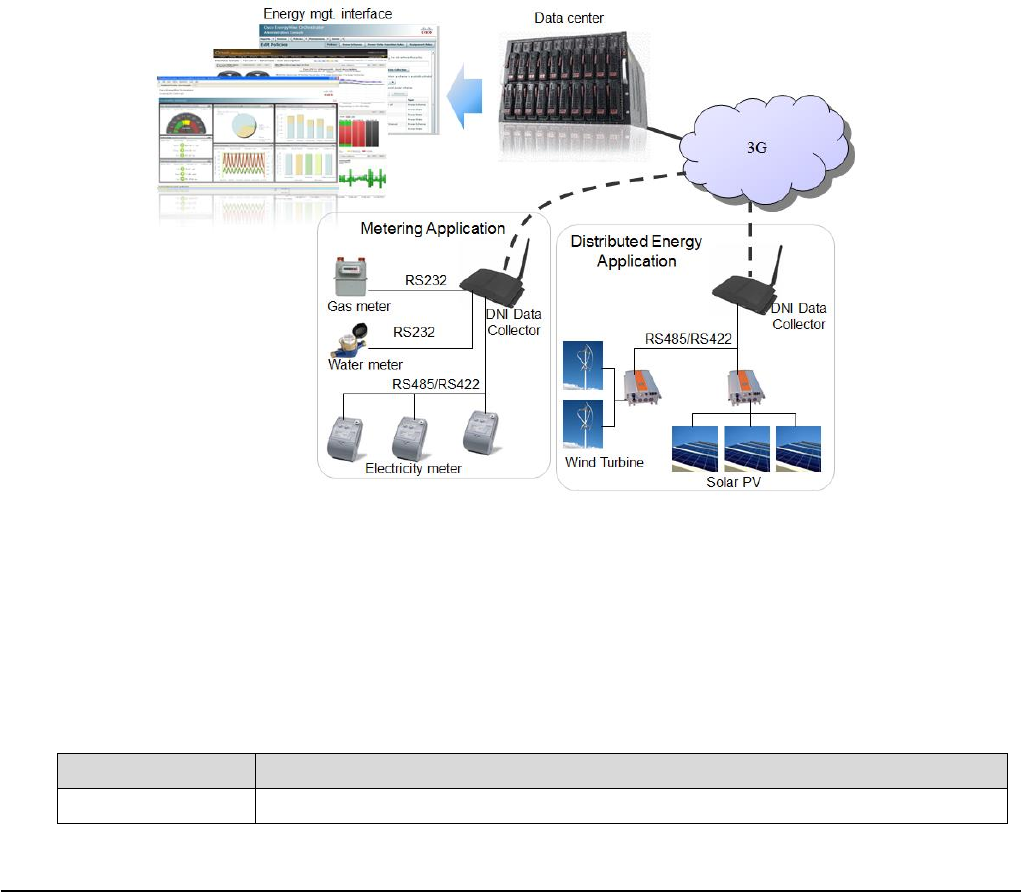
Doc #: 1ANSU-160004
DNI SGDC-D22 User Manual
i. 1
1. Introduction
1.1. General Description
DNI data collector SGDC-D22 is a 3G version ARM9 based embedded system with 3G for WAN communication and
Ethernet port, RS-232 and RS-422/485 interfaces for LAN communication as well to collect data from devices via
LAN communication and forward to data center via WAN communication. The communication capability can fulfill
the requirements in smart metering and distributed energy monitoring applications as well as the sensor network and
internet of things applications.
Figure 1, DNI data collector applications.
1.2. Target Applications
DNI data collector is an embedded system designed for smart grid applications as well as the IoT related applications.
1.3. Product Information
Model Name
Description
SGDC-D22
Data collector with 3G communication board.

Doc #: 1ANSU-160004
DNI SGDC-D22 User Manual
i. 2
1.4. Regulation declaration
The changes or modifications not expressly approved by the party responsible for compliance could void the user’s
authority to operate the equipment. To comply with the FCC RF exposure compliance requirements, this device and its
antenna must not be co-located or operating to conjunction with any other antenna or transmitter.
Note: This equipment has been tested and found to comply with the limits for a Class B Digital Device, pursuant to part
15 of the FCC Rules. These limits are designed to provide reasonable protection against harmful interference in a
residential installation. This equipment generates, uses and can radiate radio frequency energy and, if not installed and
used in accordance with the instruction, may cause harmful interference to radio communication. However, there is no
grantee that interference will not occur in a particular installation. If this equipment dose cause harmful interference to
radio or television reception, which can be determined by turning the equipment off and on, the user is encouraged to
try to correct the interference by one or more of the following measures:
--Reorient or relocate the receiving antenna.
--Increase the separation between the equipment and receiver.
--Connect the equipment into an outlet on a circuit different from that to which the receiver is connected.
--Consult the dealer or an experienced radio/TV technician for help.
This device should have at least 20 cm separation distance to persons.
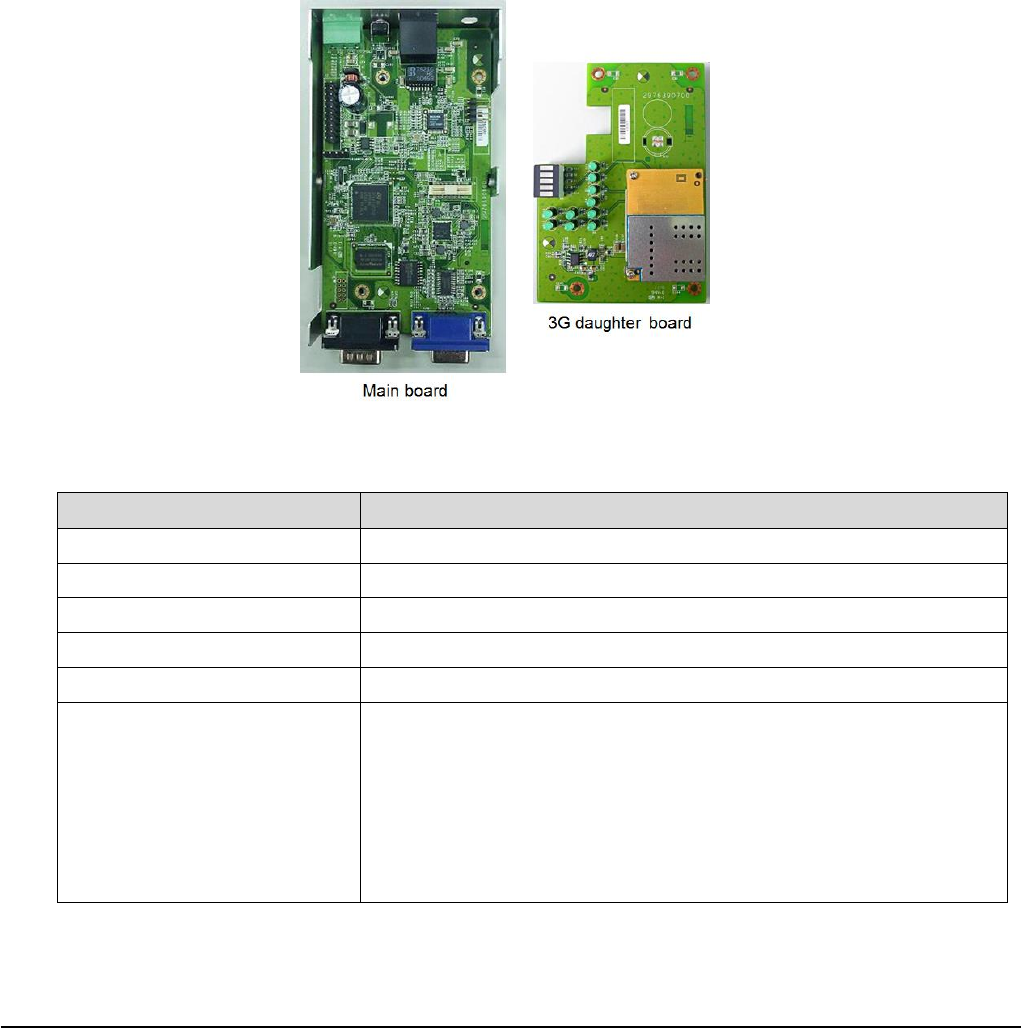
Doc #: 1ANSU-160004
DNI SGDC-D22 User Manual
i. 3
2. Platform Description
2.1. Hardware Information
DNI data collector incorporates the following hardware components as shown in Figure 2.
Figure 2, DNI data collector hardware components.
Feature
Description
Main Board
With CPU, memory and major interfaces of data collector.
3G Daughter Board
With 3G module and LED indicators.
CPU
ST SPEAr 320S
Flash
32MB (16MB 2)
DDR-II
64MB
3G Module1
3G: (model name: SGDC-D22)
Five band: UMTS/HSPA+ 1900MHz
HSPA 3GPP Release 6, 7
UMTS 3GPP release 4
Output power:
- Class 3 (+24dBm +1/-3dB) for UMTS 1900,WCDMA FDD BdII
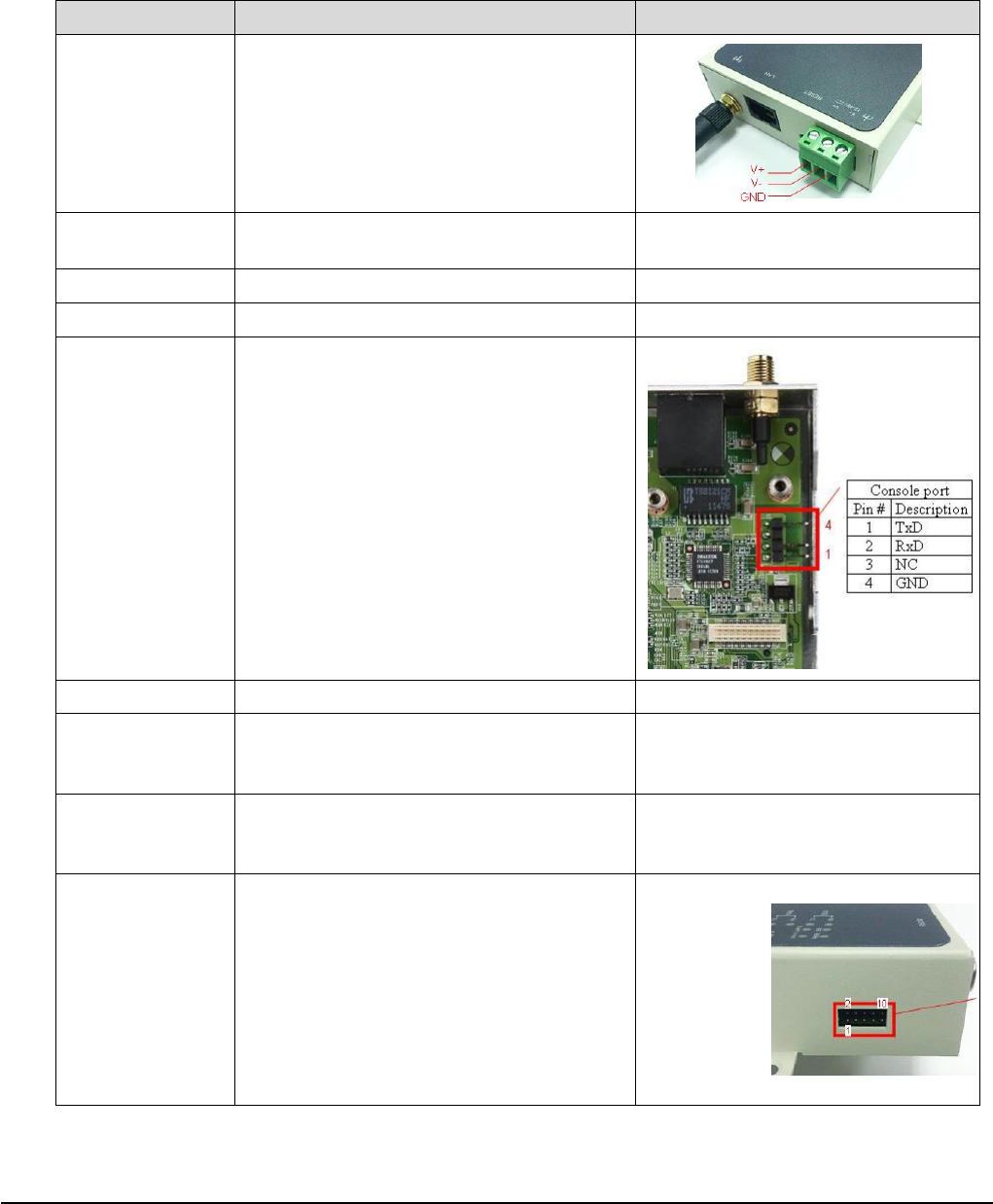
Doc #: 1ANSU-160004
DNI SGDC-D22 User Manual
i. 4
The interfaces of data collector are illustrated as following table.
Interface
Description
Note
Power
A 3-pin terminal block to connect 12-48VDC
V+, V and GND.
Reset Button
Hardware reset button. Support back to factory
default setting function.
Ethernet Port
RJ45 port for Ethernet connection.
Antenna
External antenna with SMA connector.
Console Port
Local port for direct connecting to concentrator
(RJ45 connector).
Wall Mount
2 L shape parts for wall mount installation.
RS-232
Male DB9 connector for RS-232 connection.
PIN 2: RXD
PIN 3: TXD
PIN 5: GND
RS-422/485
Female DB9 connector for RS-422/485
connection. Support switching RS-485 or
RS-422 modes by software.
Please find the pin define in separate
table.
GPIO
2x5-pin digital I/O for applications.
PIN 1: GND
PIN 2: GND
PIN 3: DI3
PIN 4: DO3
PIN 5: DI2
PIN 6: DO2
PIN 7: DI1
PIN 8: DO1
PIN 9: DI0
PIN 10: DO0
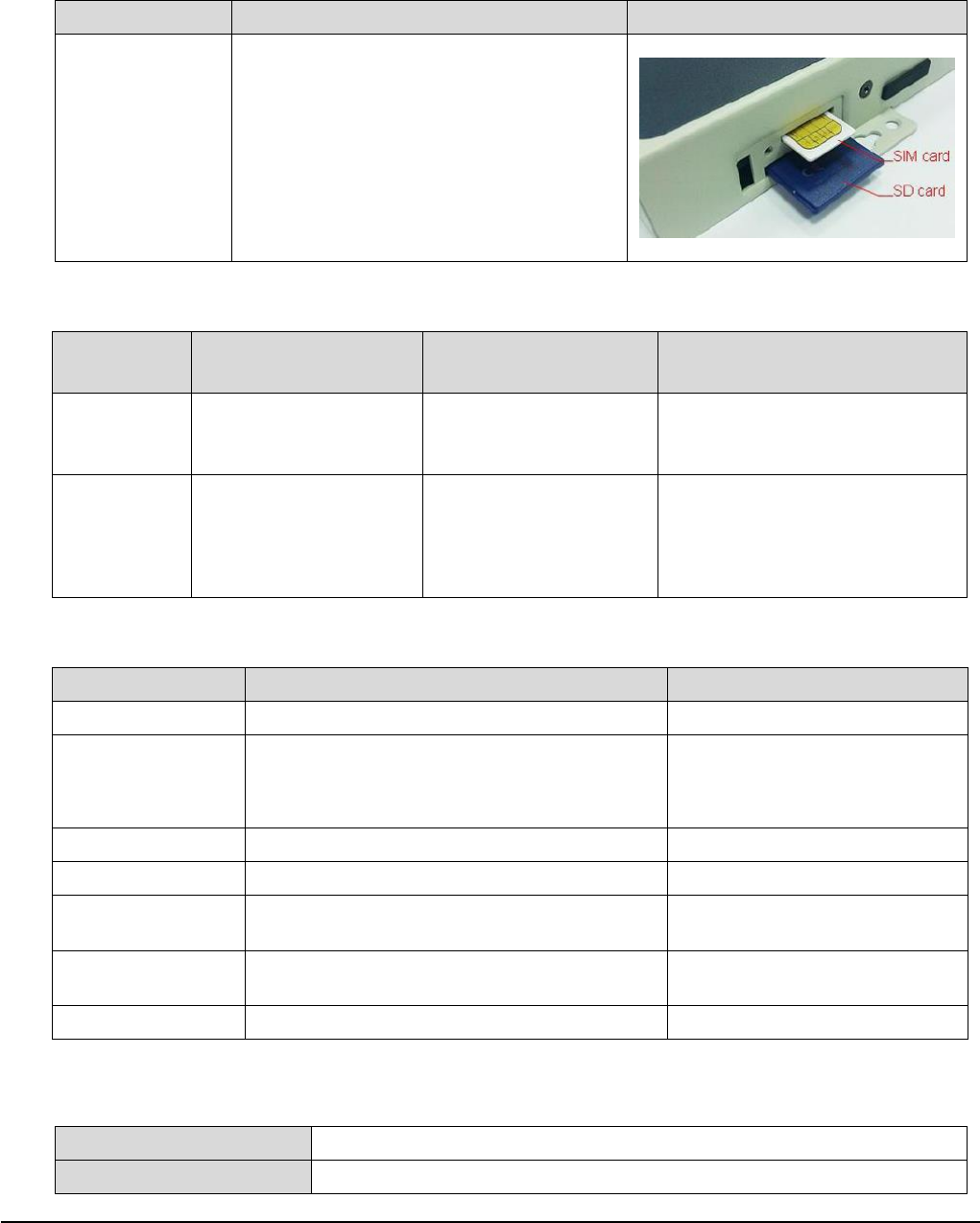
Doc #: 1ANSU-160004
DNI SGDC-D22 User Manual
i. 5
Interface
Description
Note
SIM Card &
SD Card Slots1
RS-485 pin define:
Serial Port
Device Name
Software
Switch Command
Hardware
PIN Definition
RS-485
(2-wire)
/dev/ttyM1
setport 1
PIN 1: GND
PIN 2: DATA(A)
PIN 3: DATA(B)+
RS-422
(4-wire)
/dev/ttyM1
setport 0
PIN 1: GND
PIN 2: RX
PIN 3: RX+
PIN 4: TX+
PIN 5: TX
LED display:
Feature
Description
Note
Power
Power indicator
Turn on when power on.
Ready
Get the system ready information and turn on the
ready LED when data collector connect to data
center and get response from communication
server.
Turn on when connect to data
center.
RS-232
TxD × 1, RxD × 1
Blink when communication.
RS-485
TxD × 1, RxD × 1
Blink when communication.
3G
3G connection indicator.
Turn on when 3G connected.
3G
Signal Strength1
5 levels for ZigBee signal strength indicators.
LAN10 / LAN100
2 for 10/100Mbps speed indicators
Blink when communication.
2.2. Software Information
Software Package
STLinux 2.3 or above
Operation System
Linux kernel 2.6.37 or above

Doc #: 1ANSU-160004
DNI SGDC-D22 User Manual
i. 6
Utilities
Busybox 1.19.3
File System type
Jffs2
Toolchain
Gcc v4.2.4, Glibc v2.6.1, GDB v6.3
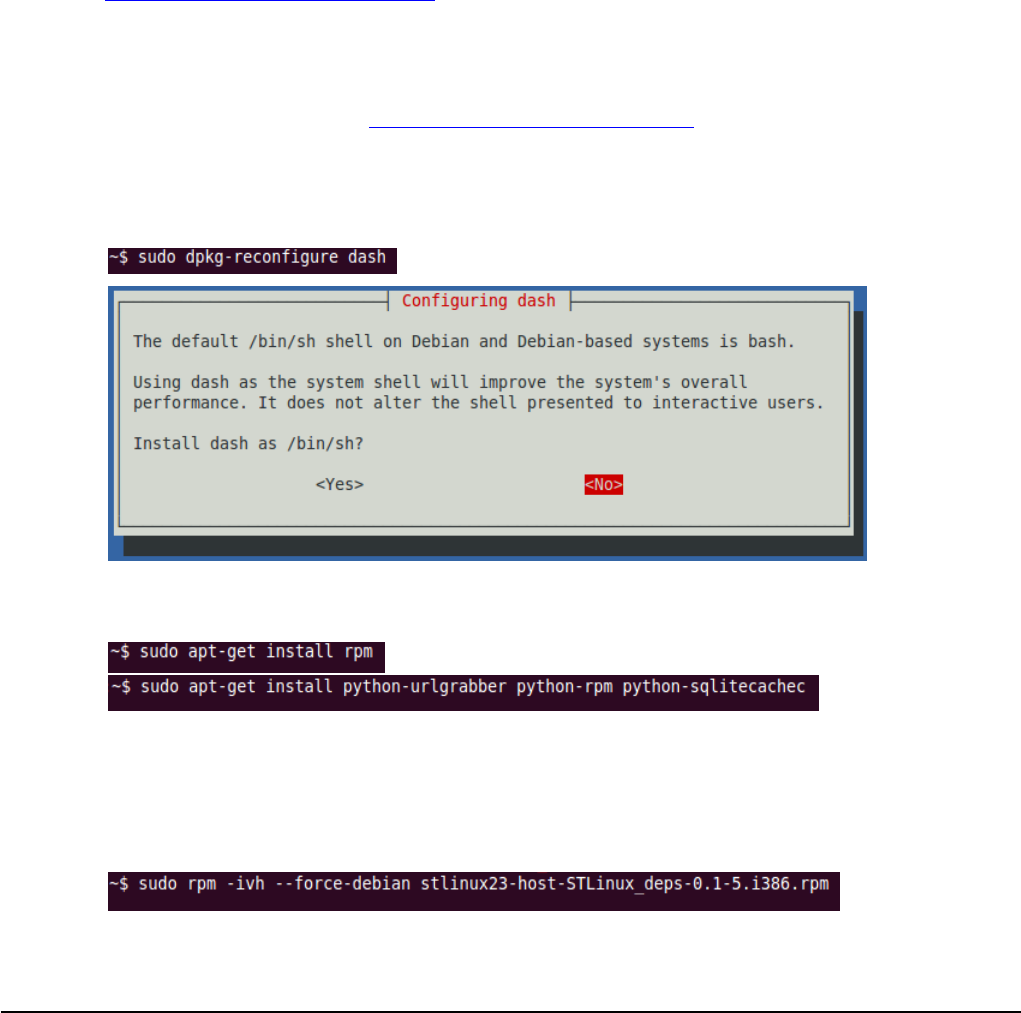
Doc #: 1ANSU-160004
DNI SGDC-D22 User Manual
i. 7
3. Tool Chain Installation
3.1. Environment
Host OS: Ubuntu 10.04
STLinux image file: STLinux-2.3-spear-20091209.iso
http://ftp.stlinux.com/pub/stlinux/2.3/iso/
3.2. Installing STLinux on Ubuntu
Please refer to the installation guide at http://www.stlinux.com/faq?q=node/361.
Installation steps:
Make /bin/sh bash
Installing RPM on Ubuntu
Populating the RPM databases with "Provides"
Download “STLinux_deps” rpm file at
http://www.stlinux.com/sites/default/files/stlinux23-host-STLinux_deps-0.1-5.i386.rpm then install it.
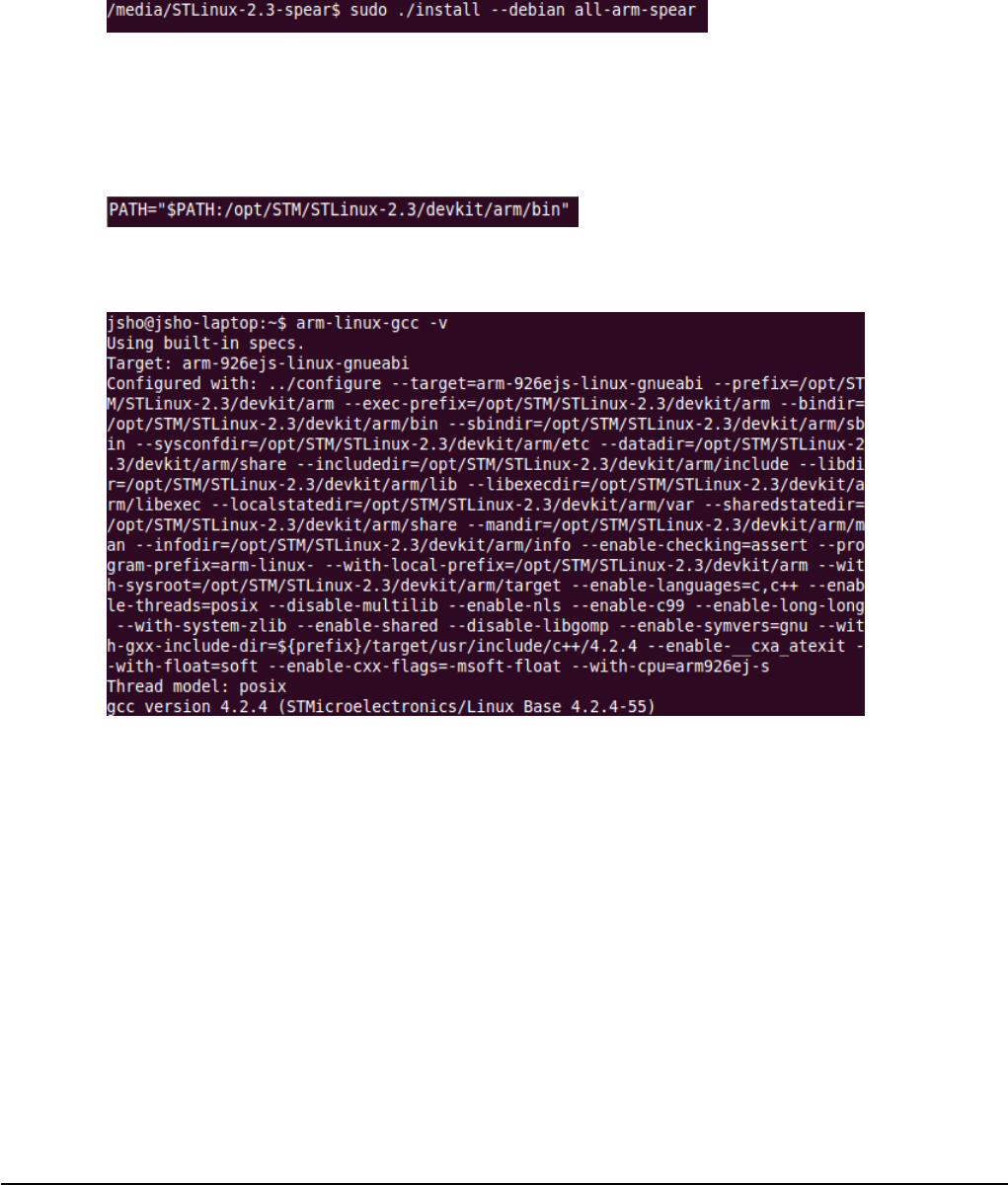
Doc #: 1ANSU-160004
DNI SGDC-D22 User Manual
i. 8
Install STLinux
Mount image file “STLinux-2.3-spear-20091209.iso” then install it.
After installation completed, STLinux package would be place at /opt/STM/STLinux-2.3/.
3.3. Add Tool Chain Path
Add tool chain path at ~/.bashrc then re-login.
Test tool chain
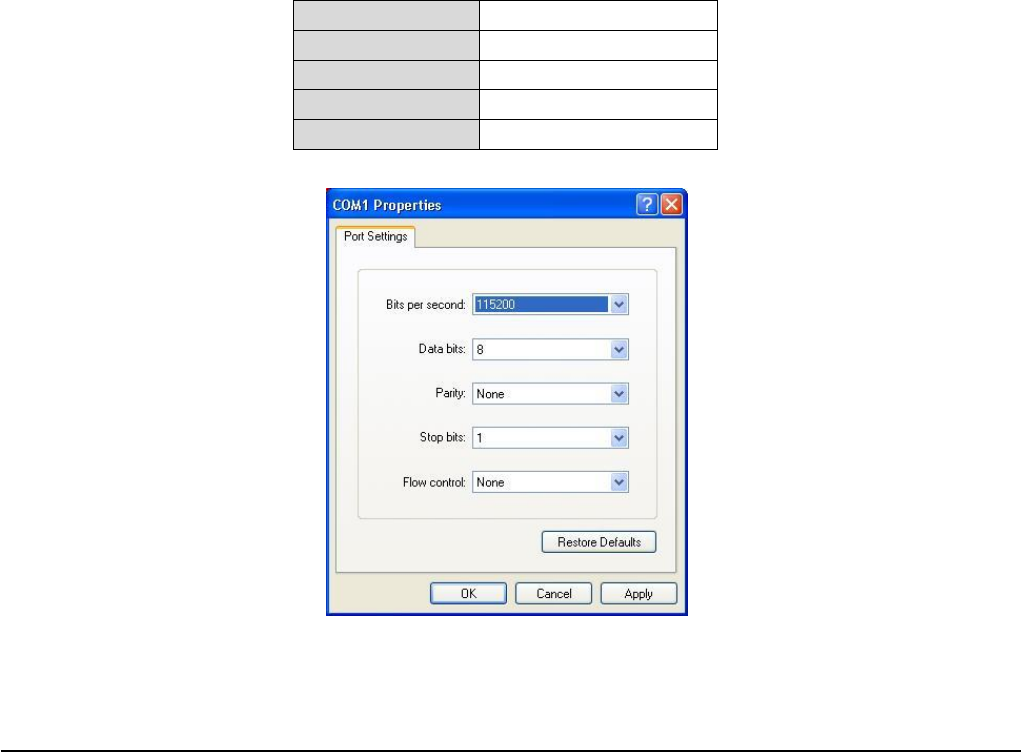
Doc #: 1ANSU-160004
DNI SGDC-D22 User Manual
i. 9
4. Getting Started
4.1. Connect to PC
DNI data collector provides two interfaces for PC to login, configure and maintenance. Users can connect to a PC
through a serial console port (RS-232) or by using SSH utility over the network connection. This section will describe
how to connect DNI data collector to PC through these two interfaces.
4.1.1. Serial Console Port (RS-232)
When using the serial console port to connect, first, make sure the console cable is correctly connected between DNI
data collector and a host PC.
Then open a serial port terminal emulator (e.g. Hyper Terminal or PuTTY) and fill the port settings as shown in the
following table.
Baud Rate
115200 bps
Parity
None
Data Bits
8
Stop Bit
1
Flow Control
None
Figure 3, Hyper Terminal Com Port Properties.
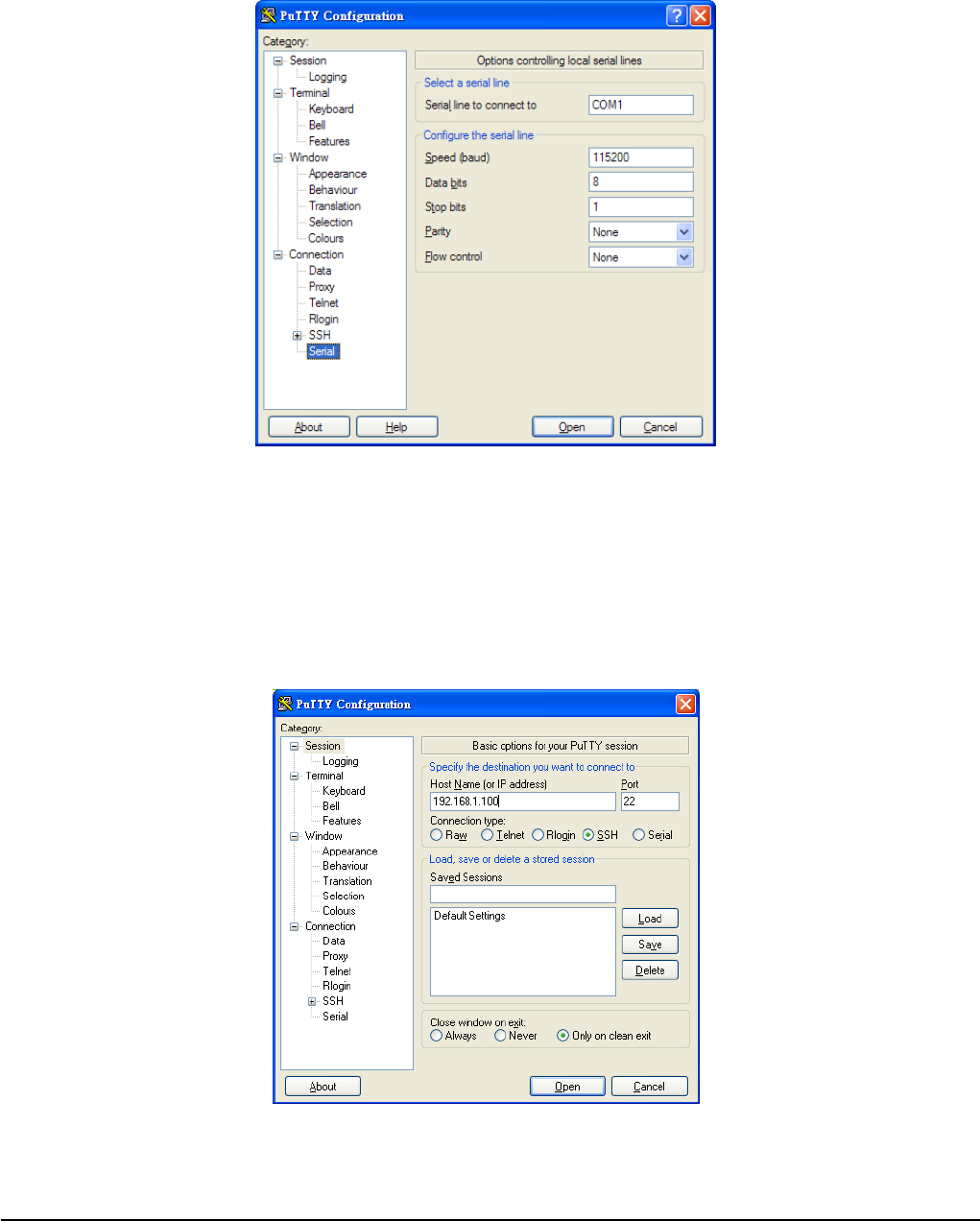
Doc #: 1ANSU-160004
DNI SGDC-D22 User Manual
i. 10
Figure 4, PuTTY Configuration for Serial Connection.
4.1.2. SSH Utility (Network)
By default, DNI data collector enables the SSH service to support remote log in. The default network IP of DNI data
collector is 192.168.1.100. Please also make sure that the IP used by PC is also in the 192.168.1.x subnet. The network
cable can be connected directly between a PC and a DNI data collector.
Figure 5, PuTTY Configuration for SSH Connection.
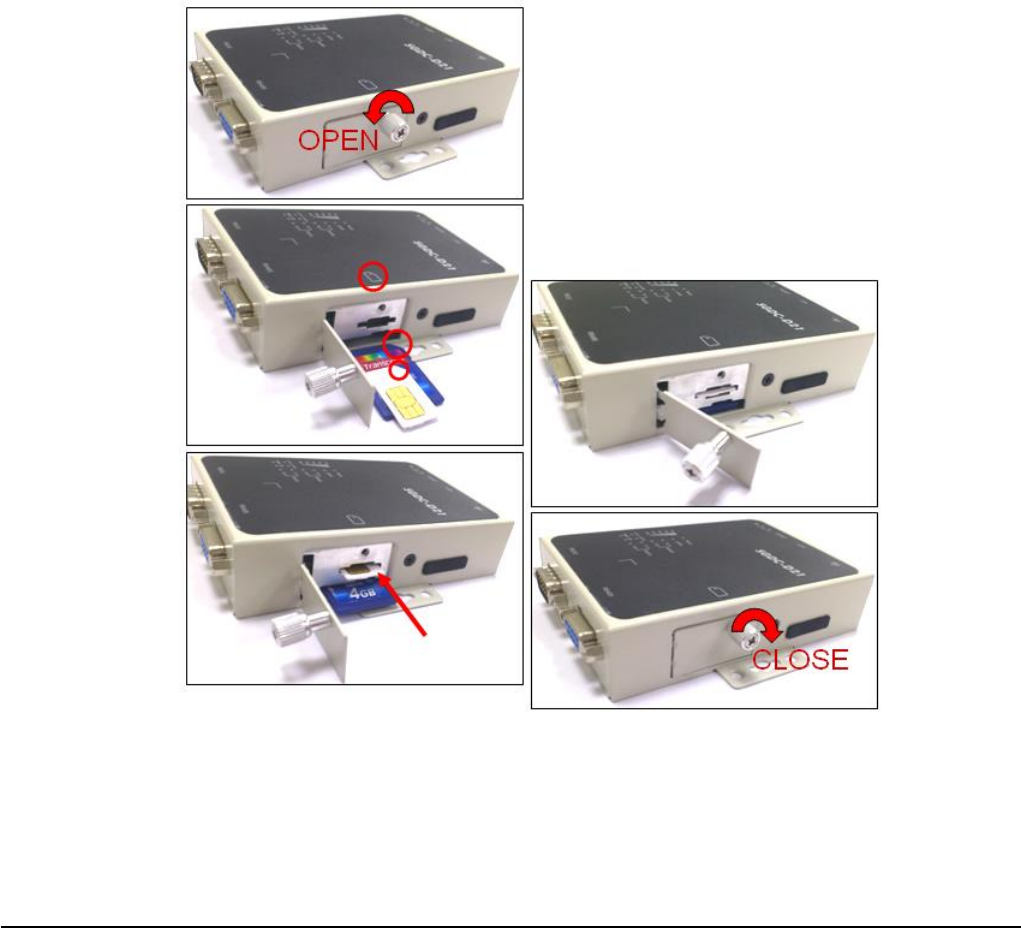
Doc #: 1ANSU-160004
DNI SGDC-D22 User Manual
i. 11
4.2. SIM Card and SD Card Installation
The SIM card and SD card slots are behind the left side cover gate of the SGDC-D22. Please refer to the following
picture and instructions to install SIM card and SD card.
1. Open the cover gate by rotating the screw in anti-clockwise way.
2. Insert the SIM card and SD card into the slot in correct direction. (The unfilled corner is on the right side.)
3. Close the cover gate by rotating the screw in clockwise direction, and be sure the gate is closed when the device is
power-on.
Figure 6, SIM card and SD card installation
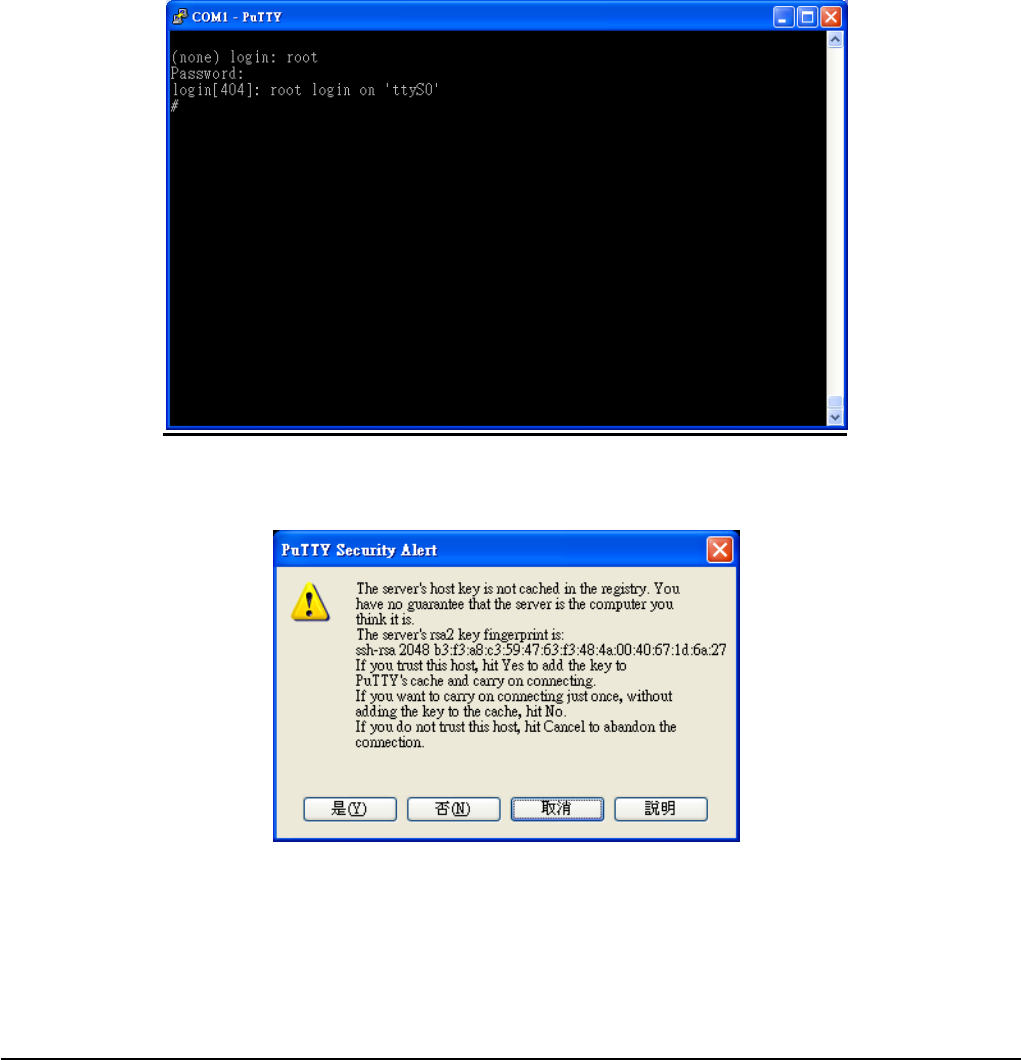
Doc #: 1ANSU-160004
DNI SGDC-D22 User Manual
i. 12
4.3. Login Data Collector
Once the connection (either serial or SSH) is established, a prompt for login will be shown in the window. The default
account for log in is root. The default password for root is ‘dnidni’. First time to log in through SSH, some terminal
emulator may show alerts that the host key is unknown, please accept it and continue the log in procedure.
Figure 7, Data collector Log In Example Output (Serial).
Figure 8, Putty Security Alert.

Doc #: 1ANSU-160004
DNI SGDC-D22 User Manual
i. 13
Figure 9, Data collector Log In Example Output (SSH).
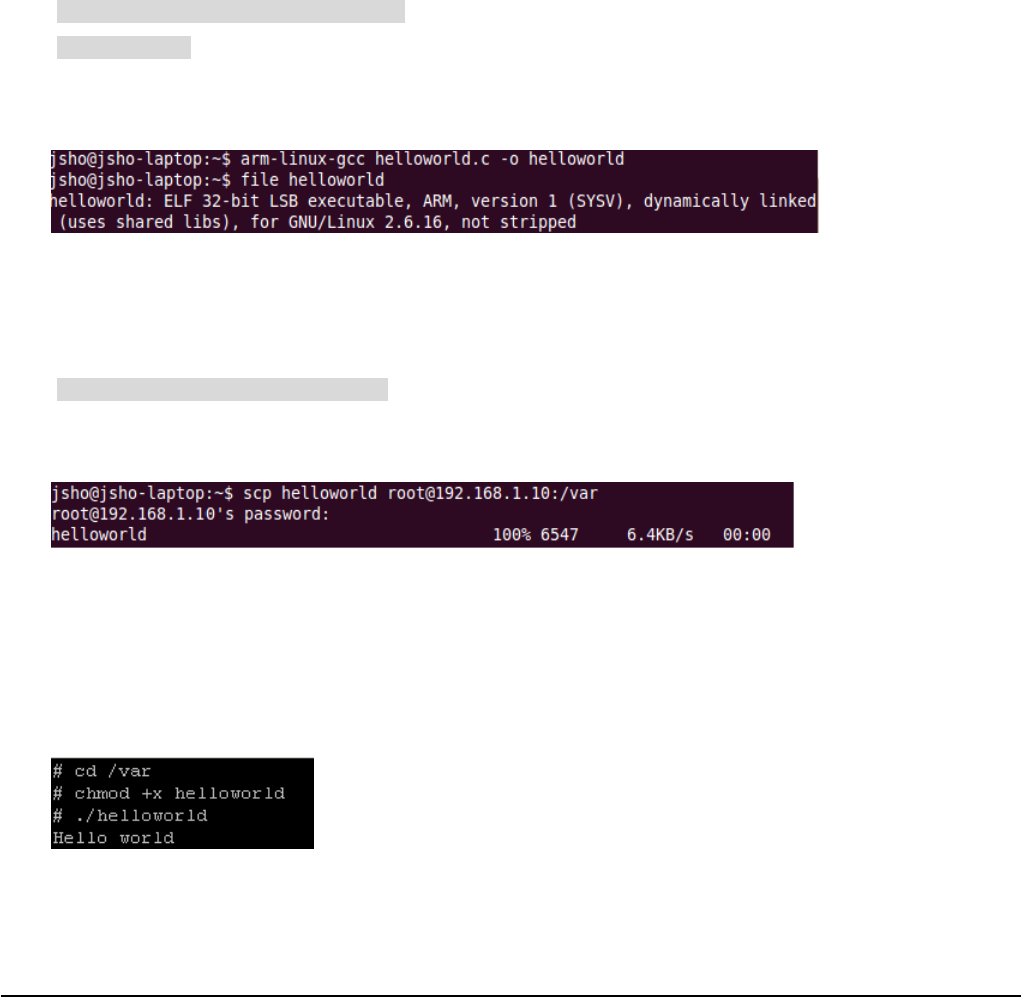
Doc #: 1ANSU-160004
DNI SGDC-D22 User Manual
i. 14
5. The First Program
5.1. Compile helloworld.c
Use cross compiler at host to compile the program for data collector.
Use “file” command to check the program after compiling.
# arm-linux-gcc helloworld.c -o helloworld
# file helloworld
Result:
5.2. Send Files to Data Collector
Use “scp” command at host to send the file to data collector.
# scp helloworld root@192.168.1.10:/var
Result:
5.3. Execute Program at Data Collector
Execute the program at the data collector.
Result:

Doc #: 1ANSU-160004
DNI SGDC-D22 User Manual
i. 15
6. Communication Settings
6.1. Static IP on eth0
To set the static IP for DCU in eth0, please edit /etc/network/interfaces
# vi /etc/network/interfaces
auto eth0
iface eth0 inet static
address 192.168.1.100
network 192.168.1.0
netmask 255.255.255.0
broadcast 192.168.1.255
gateway 192.168.1.254
And you can apply this configuration by executing the following command:
# set-static-ip
6.2. DHCPD and DHCP Client
DCU can act as a DHCP server to assign IP to the client in the same network.
Enable DHCPD:
# udhcpd
Edit the /etc/udhcpd.conf if needed.
# vi /etc/udhcpd.conf
start 192.168.1.20
end 192.168.1.99
interface eth0
opt router 192.168.1.254
option subnet 255.255.255.0
option lease 600 # 10min
opt dns 168.95.1.1 168.95.192.1
#static_lease 00:13:96:03:a7:ed 192.168.1.30
#static_lease 00:13:96:03:a5:f0 192.168.1.31
DCU also can act as a DHCP client to get IP configuration from DHCP server.
# dhcpip
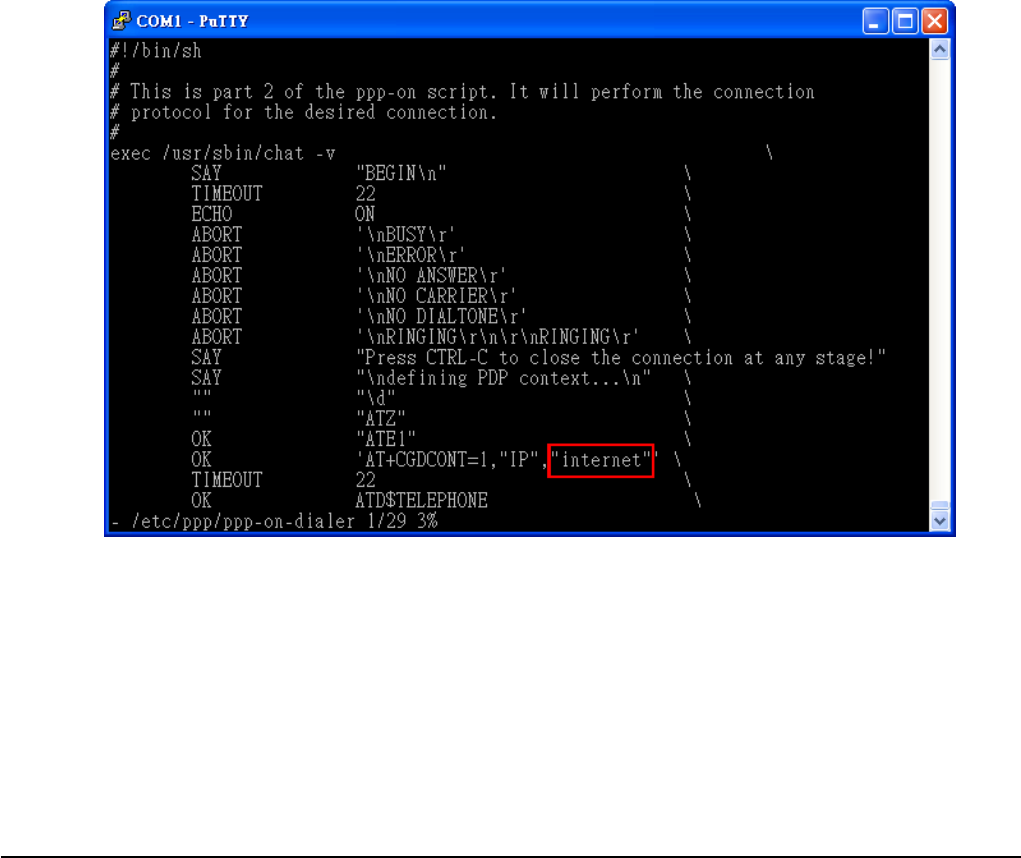
Doc #: 1ANSU-160004
DNI SGDC-D22 User Manual
i. 16
To act as dhcp server or client on booting, it can be configured in /etc/rc.d/rc.local.
6.3. 3G
Before using 3G communication, please insert a SIM card into the slot on the 3G module. The position of the SIM slot
and the direction of SIM card please refer to the section 4.2.
DNI data collector uses pppd to handle the 3G connection. 3G service providers have their own setting such as APN
and dial number. Please contact the provider to get the correct values. The APN value is defined in
/etc/ppp/ppp-on-dialer. And the dial number is in /usr/sbin/3g-connect.
Figure 10, Change APN.
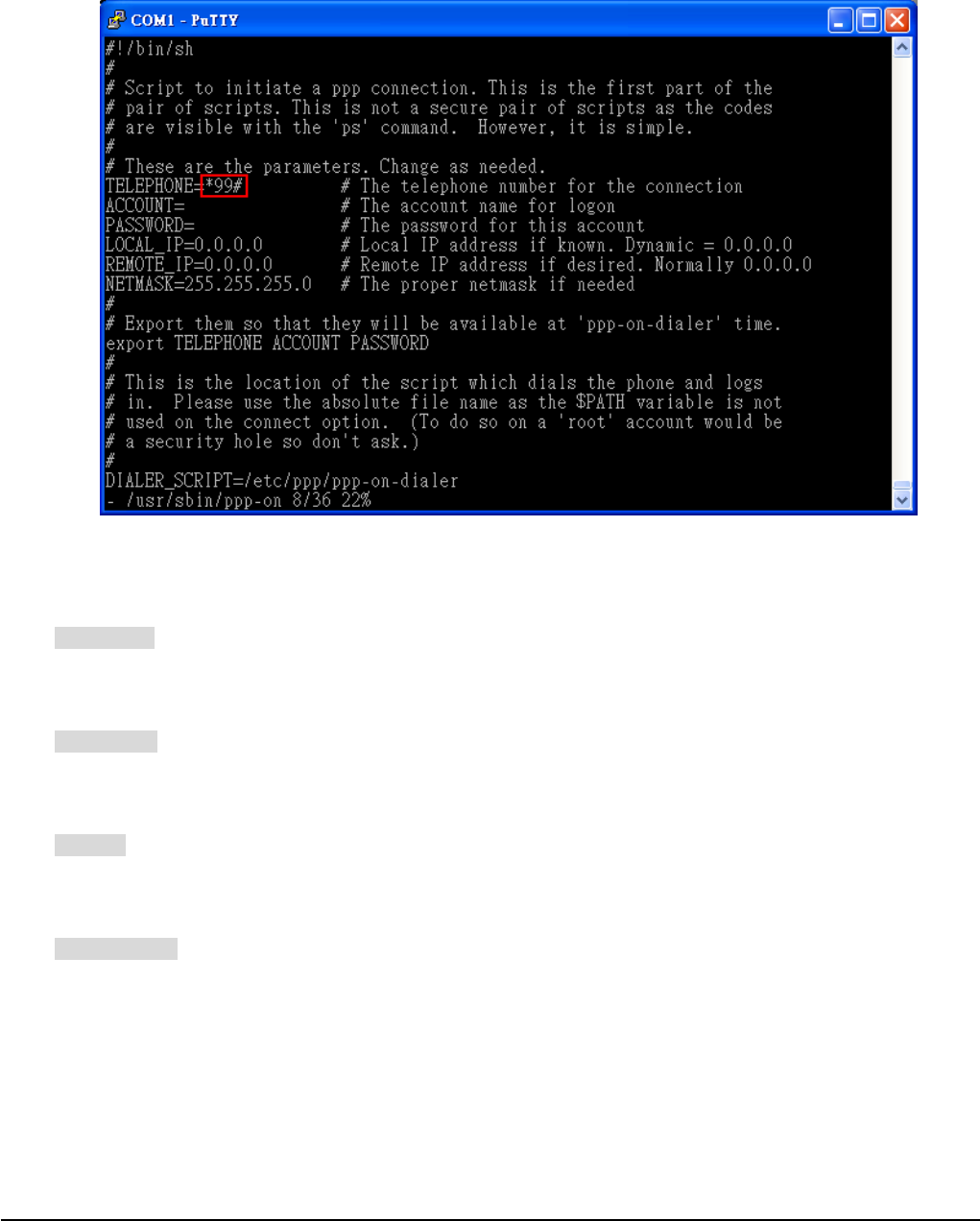
Doc #: 1ANSU-160004
DNI SGDC-D22 User Manual
i. 17
Figure 11, Change Dial Number.
After confirm the APN and the dial number, use the following command to connect a 3G service.
# 3g-connect
You also can get RSSI value and reflash the signal strength led status by using the following command.
# get-rssi-ber
To get imsi code, use the command below.
# getimsi
Use the command below to disconnect the 3G service.
# 3g-disconnect
6.4. PPPoE over eth0
To access Internet via the service form your ISP, e.g. ADSL, you can use PPPoE to connect to your ISP. Before using
PPPoE, you need to request your ISP to setup an ADSL modem in your house and get some information, e.g.
username and password, which is needed on setting your connection.
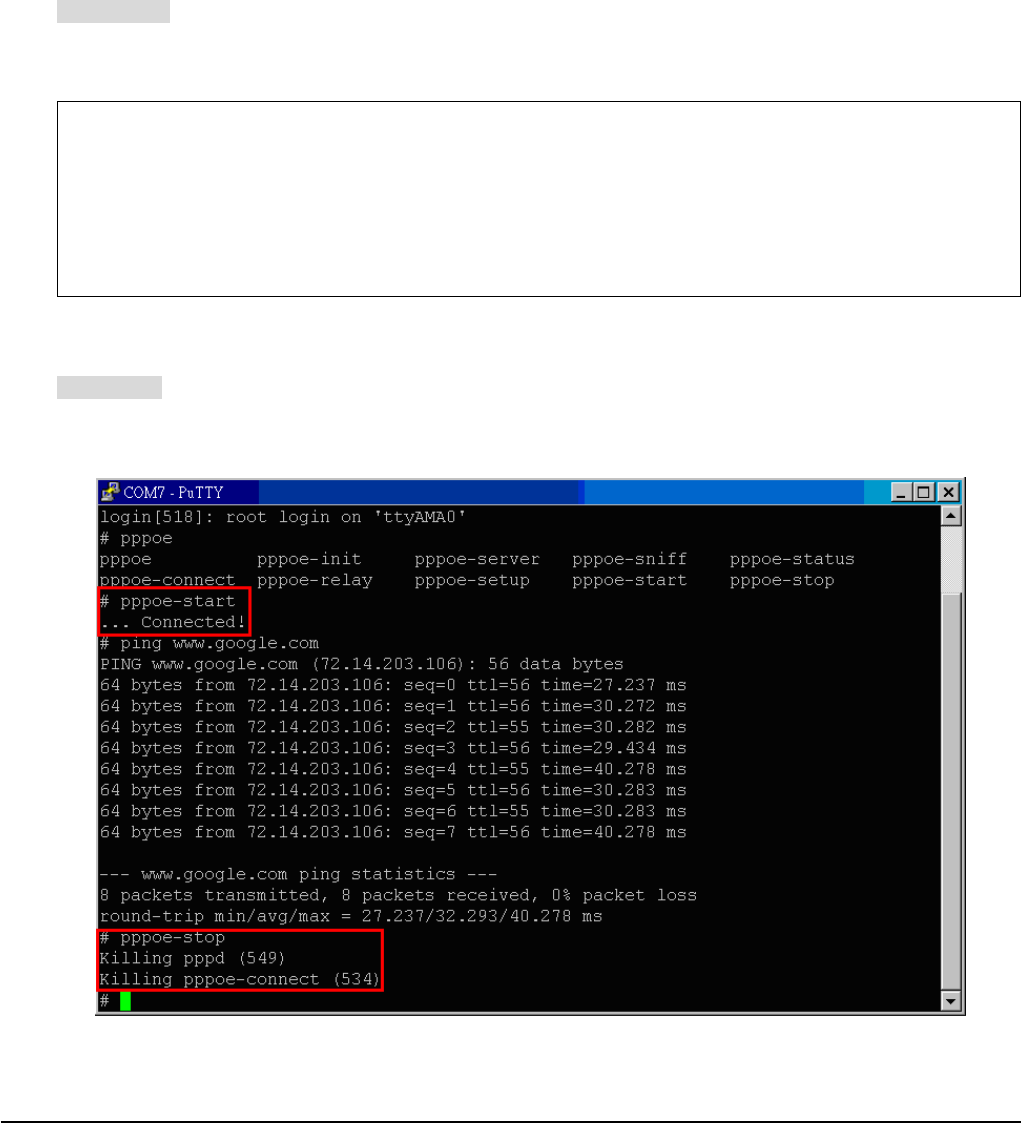
Doc #: 1ANSU-160004
DNI SGDC-D22 User Manual
i. 18
When ADSL modem is ready to use, please use Ethernet cable to connect DCU and ADSL modem and execute the
following command to connect to your ISP.
First, you need to setup the parameters for the PPPoE connection.
# pppoe-setup
Please answer the following questions:
>>> Enter your PPPoE user name: your_username
>>> Enter the Ethernet interface connected to the DSL modem: (default eth0): eth0
>>> Enter the demand value (default no): no
>>> Enter the DNS information here: server (Please enter a specific DNS server IP when ISP has provided it to you.)
>>> Please enter your PPPoE password: your_password
>>> Choose a type of firewall (0-2): 0
>>> Accept these settings and adjust configuration files (y/n)? y
After setting up parameters, use the following command to conect to the remote server:
# pppoe-start
When the connection is built up, there will be a message “… Connected! ” on the console.
Figure 12, Connect and disconnect with PPPoE.

Doc #: 1ANSU-160004
DNI SGDC-D22 User Manual
i. 19
When you want to disconnect, use the following command to disconnect the PPPoE connection.
# pppoe-stop
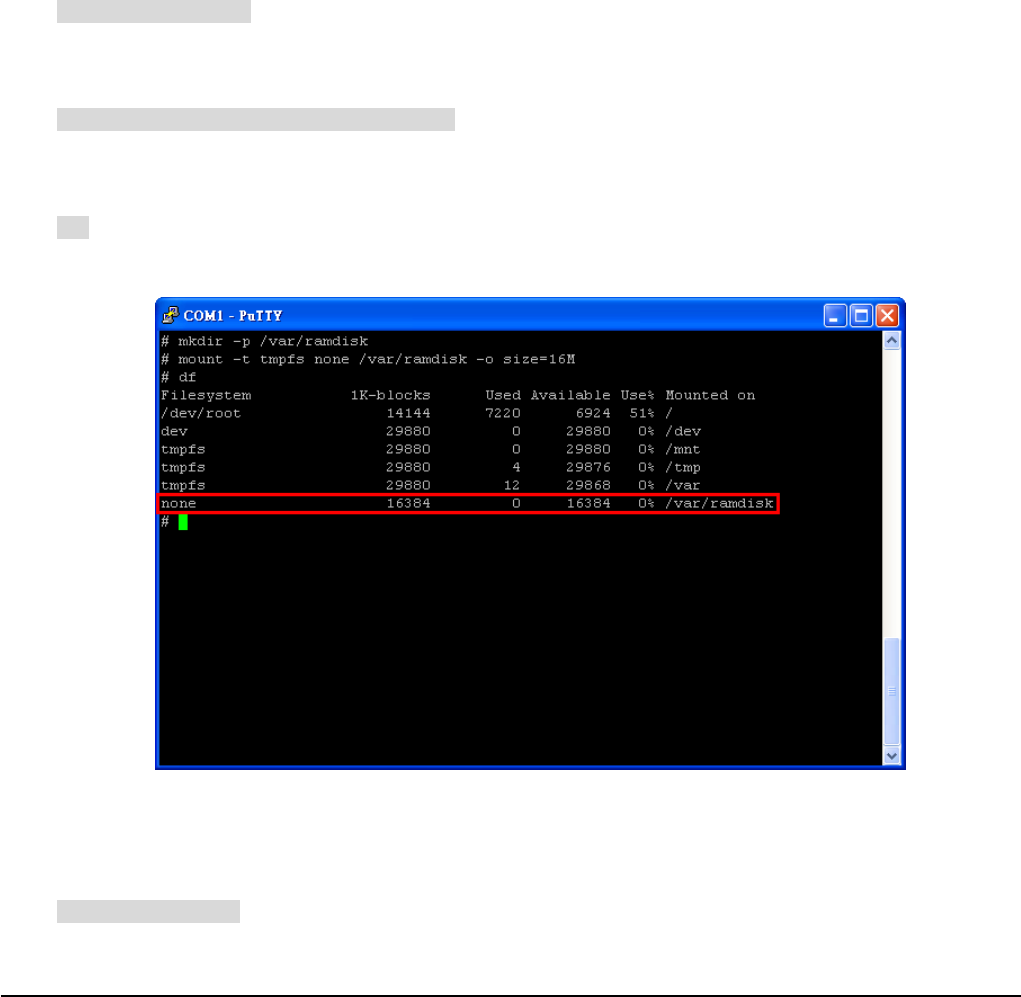
Doc #: 1ANSU-160004
DNI SGDC-D22 User Manual
i. 20
7. Daemons & Utilities
7.1. Ramdisk
To mount a virtual disk on the memory, you can execute the following command to create a ramdisk.
Create a directory for ramdisk:
# mkdir –p /var/ramdisk
Allocate a specific memory size and mount it to the ramdisk:
# mount –t tmpfs none /var/ramdisk –o size=16M
Finally, you can use df command to check the information of the ramdisk you created.
# df
Figure 13, Mount a ramdisk with 16MB size.
If you want to umount the ramdisk, use the command below:
# umount /var/ramdisk
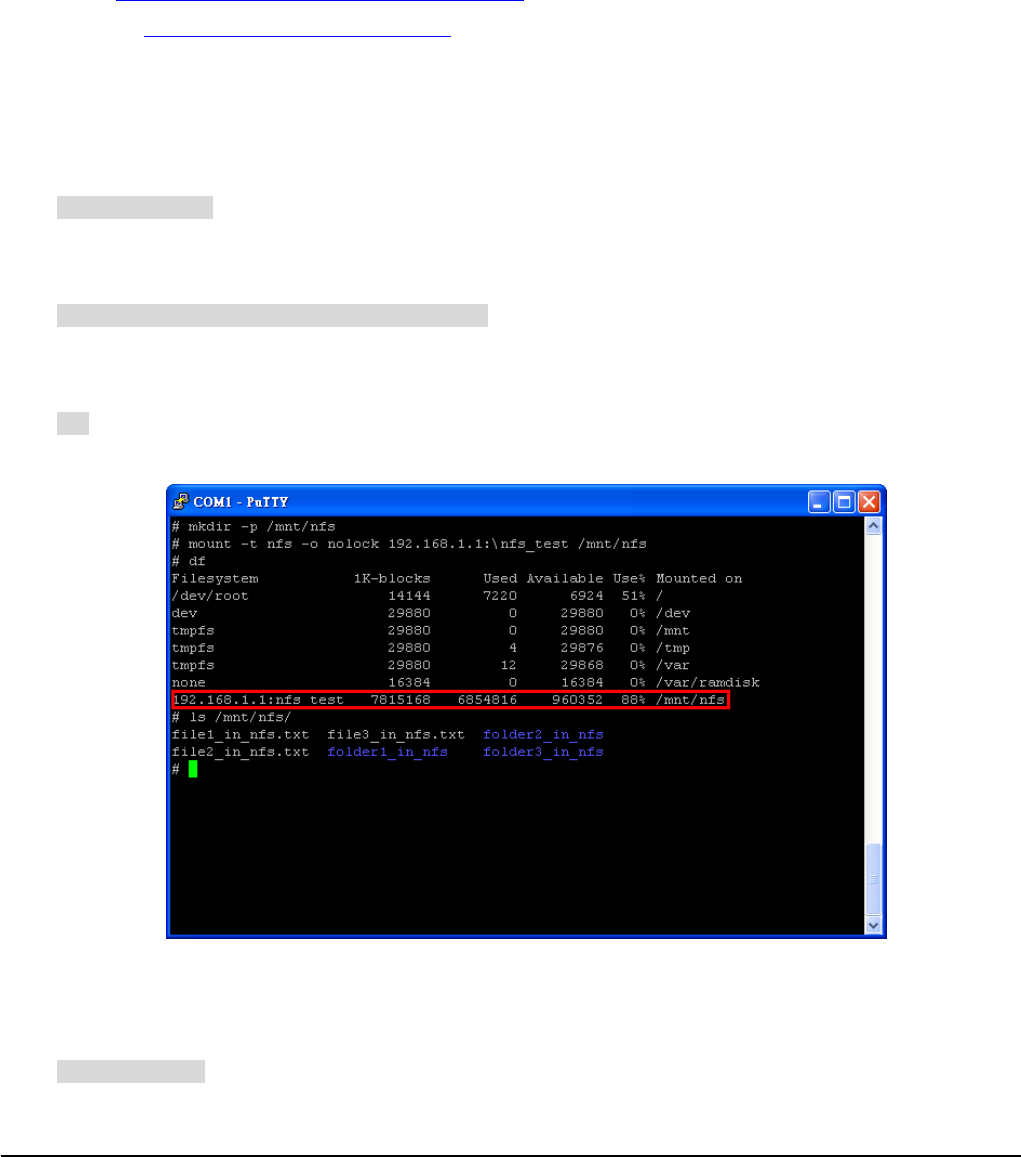
Doc #: 1ANSU-160004
DNI SGDC-D22 User Manual
i. 21
7.2. NFS (Network File System)
Before using NFS, a NFS server is needed. To create a NFS server on your PC, please refer to:
Linux: http://tldp.org/HOWTO/NFS-HOWTO/server.html
Windows: http://sourceforge.net/projects/freenfs/
When your NFS server is ready, please execute the following commands to connect to your NFS server.
Create a directory for NFS:
# mkdir -p /mnt/nfs
Mount NFS server directory to your local directory:
# mount -t nfs -o nolock server_IP:/directory /mnt/nfs
Finally, you can use df command to check the information of NFS directory you mounted.
# df
Figure 14, Mount a remote directory to the local one via NFS.
If you want to disconnect and umount from the NFS server, use the command below:
# umount /mnt/nfs
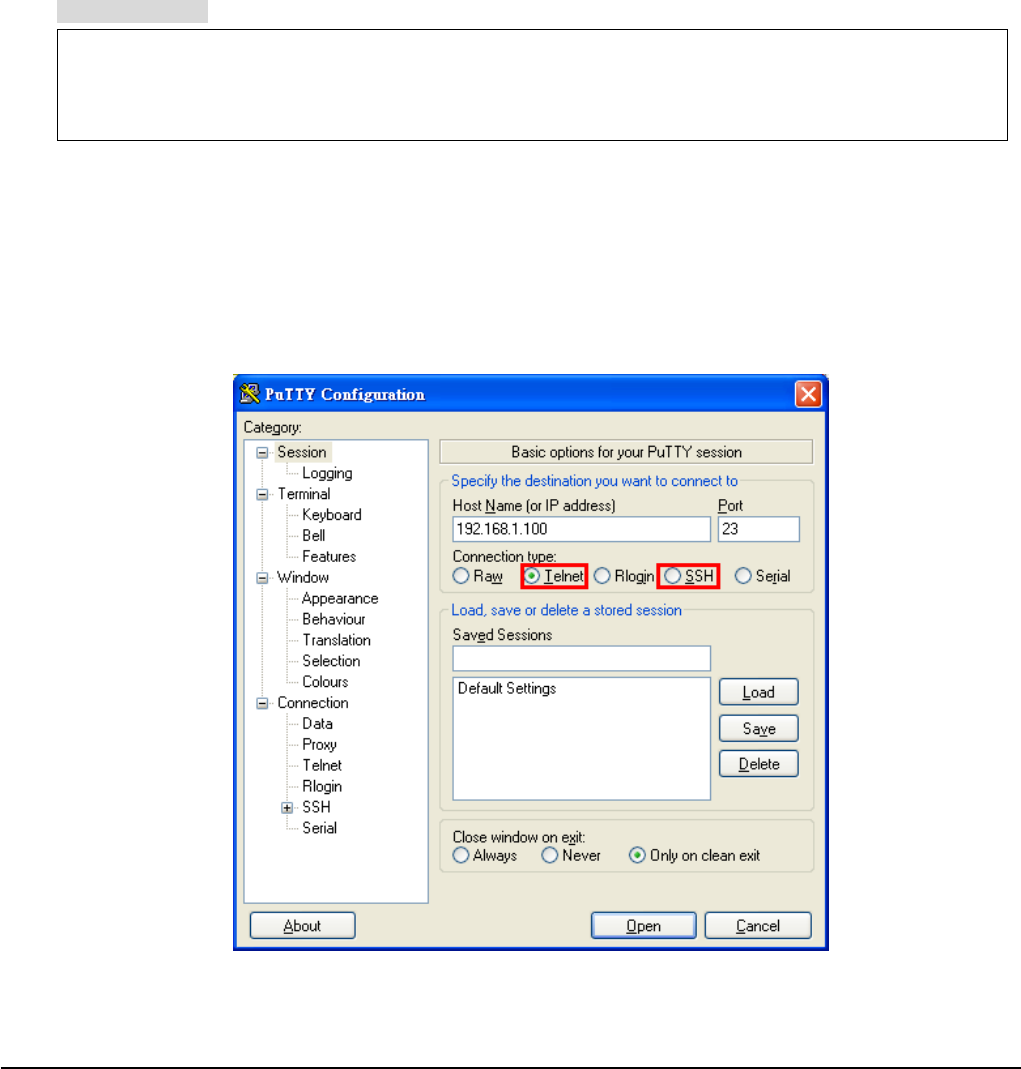
Doc #: 1ANSU-160004
DNI SGDC-D22 User Manual
i. 22
7.3. Telnet & SSH Service
Telnet and SSH can be used to remote login to the DCU. SSH uses encryption transportation, and the transportation on
Telnet is only by ACSII code.
You can turn on those services on the /etc/inetd.conf to make them as auto-run daemon after booting.
# vi /etc/inetd.conf
ftp stream tcp nowait root /usr/local/sbin/pure-ftpd pure-ftpd -H &
telnet stream tcp nowait root /usr/sbin/telnetd telnetd -i
ssh stream tcp nowait root /usr/bin/dropbear dropbear -i
#www stream tcp nowait root /usr/sbin/httpd httpd -i -h /home/htdocs
The default port of telnet service will be port 23.
The default port of SSH service will be port 22.
You can use PuTTY or other terminal programs to login DCU via those protocols.
Figure 15, Use Putty to create a telnet or SSH connection.
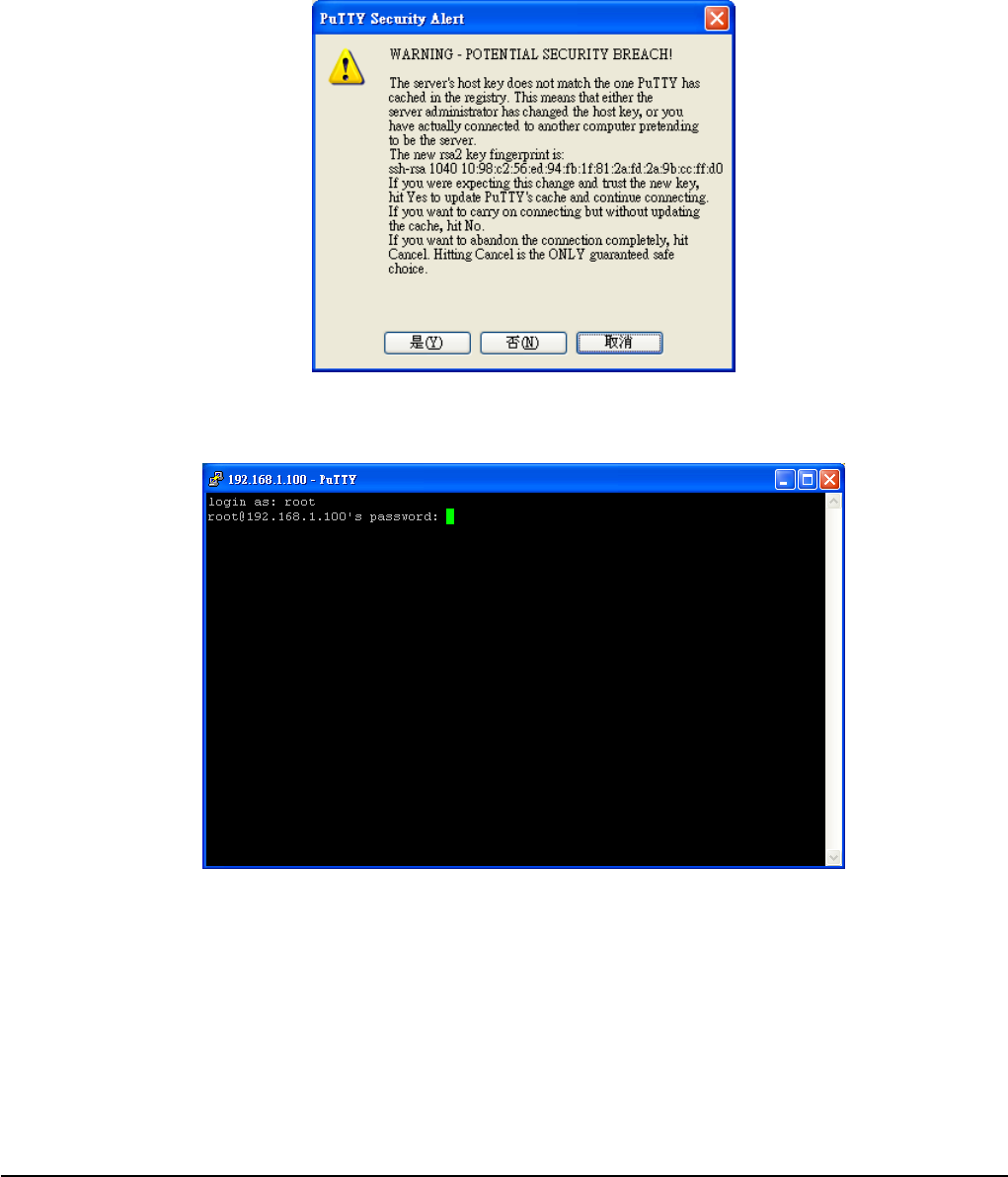
Doc #: 1ANSU-160004
DNI SGDC-D22 User Manual
i. 23
There will be a notification to user to update the key on your PC, when SSH protocol is used. Press “Yes” to allow this
operation.
Figure 16, Notification for key updating.
Figure 17, Login to the DCU via telnet or SSH.
Default username/password: root/dnidni
After login, you can operate the DCU remotely.

Doc #: 1ANSU-160004
DNI SGDC-D22 User Manual
i. 24
7.4. FTP & SCP
FTP and SCP can be used for file transmission to the DCU. Ftp is the normal way to transmit file on the internet, and
SCP is a file transmission way on the SSH protocol.
You can turn on those services on the /etc/inetd.conf to make them as auto-run daemon after booting.
# vi /etc/inetd.conf
ftp stream tcp nowait root /usr/local/sbin/pure-ftpd pure-ftpd -H &
telnet stream tcp nowait root /usr/sbin/telnetd telnetd -i
ssh stream tcp nowait root /usr/bin/dropbear dropbear -i
#www stream tcp nowait root /usr/sbin/httpd httpd -i -h /home/htdocs
The default port of ftp service will be port 21.
SCP:
SCP can be used correctly when SSHd is turned on.
FTP/SCP client on PC:
FTP: http://filezilla-project.org/download.php
SCP: http://winscp.net/
FTP/SCP client on DCU
FTP:
# ftpget –u username –p password HOST_IP [LOCAL_FILE] REMOTE_FILE
# ftpput –u username –p password HOST_IP REMOTE_FILE [LOCAL_FILE]
SCP:
# scp root@HOST_IP:/REMOTE_FILE LOCAL_FILE
# scp LOCAL_FILE root@HOST_IP:/REMOTE_FILE
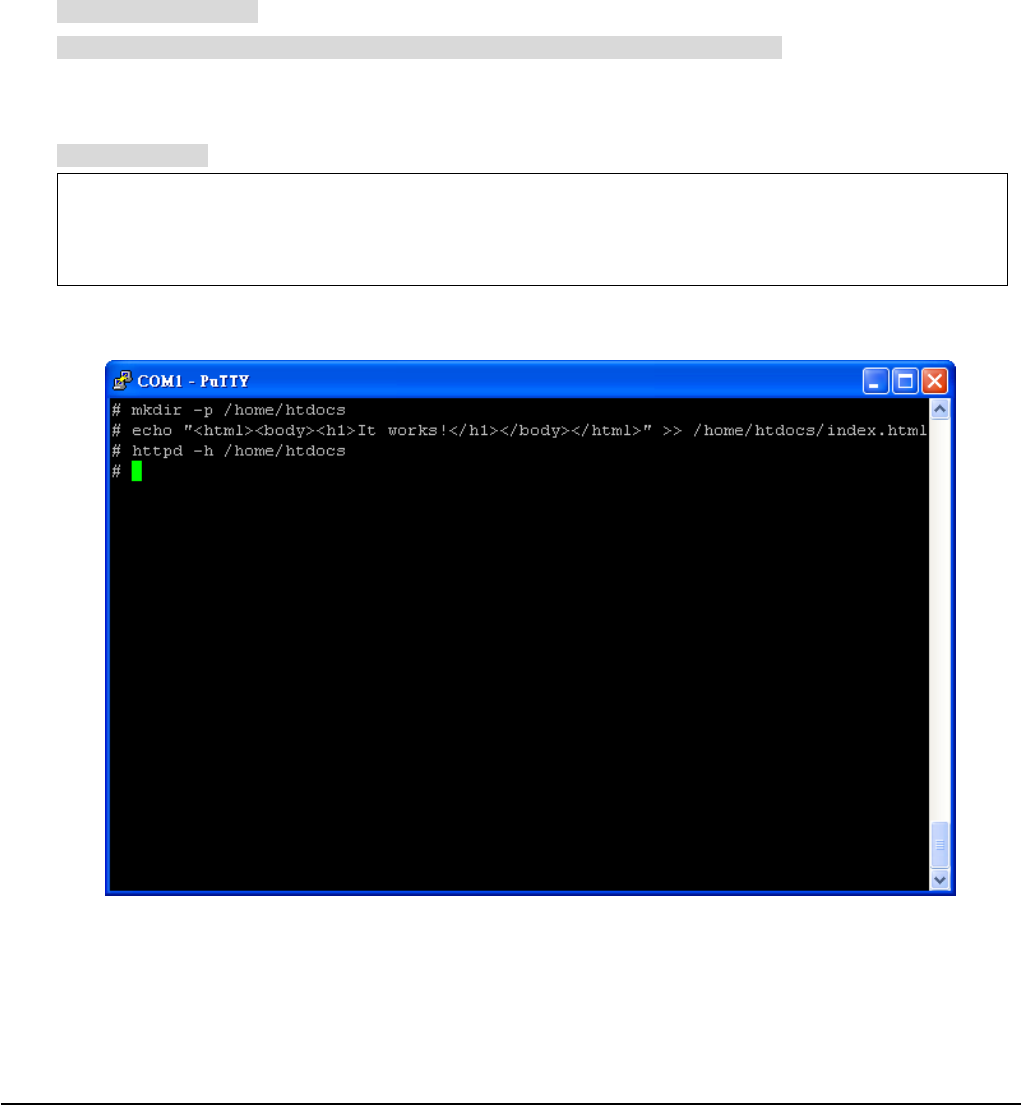
Doc #: 1ANSU-160004
DNI SGDC-D22 User Manual
i. 25
7.5. HTTP
DCU can act as a simple HTTP WEB server, and you can follow the command below to build up your own web server.
Create a folder for WEB server and create a homepage.
# mkdir –p /home/htdocs
# echo "<html><body><h1>It works!</h1></body></html>" >> /home/htdocs/index.html
You can turn on those services on the /etc/inetd.conf to make them as auto-run daemon after booting.
# vi /etc/inetd.conf
ftp stream tcp nowait root /usr/local/sbin/pure-ftpd pure-ftpd -H &
telnet stream tcp nowait root /usr/sbin/telnetd telnetd -i
ssh stream tcp nowait root /usr/bin/dropbear dropbear -i
www stream tcp nowait root /usr/sbin/httpd httpd -i -h /home/htdocs
Figure 18, Create a simple web server.

Doc #: 1ANSU-160004
DNI SGDC-D22 User Manual
i. 26
You can use browser to show the page you created if the httpd is running well.
Figure 19, Web page from Http server.
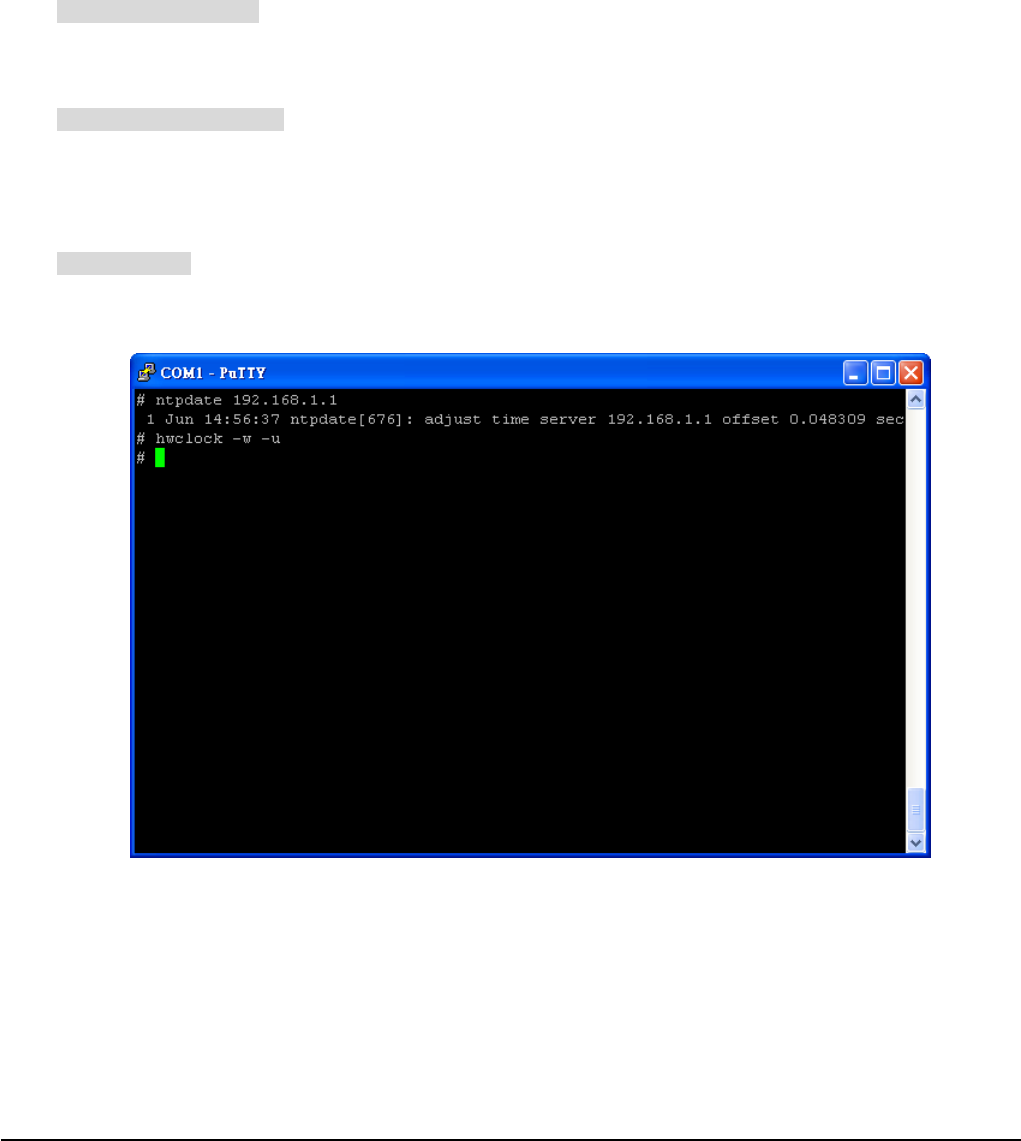
Doc #: 1ANSU-160004
DNI SGDC-D22 User Manual
i. 27
7.6. NTP & RTC
NTP protocol is used to synchronize the time between DCU and the time server. You need to find a NTP server and
use the following command to adjust the time on DCU.
# ntpdate <ntpserver_ip>
If there is no NTP server that DCU can reach, you can also adjust Linux system time manually.
# date MMDDhhmmYYYY
After adjusting Linux system time, you need to save the correct time to the HW RTC. Please execute the following
command to save time to RTC.
# hwclock -w –u
Figure 20, Time synchronization with ntp server and write back to the RTC.
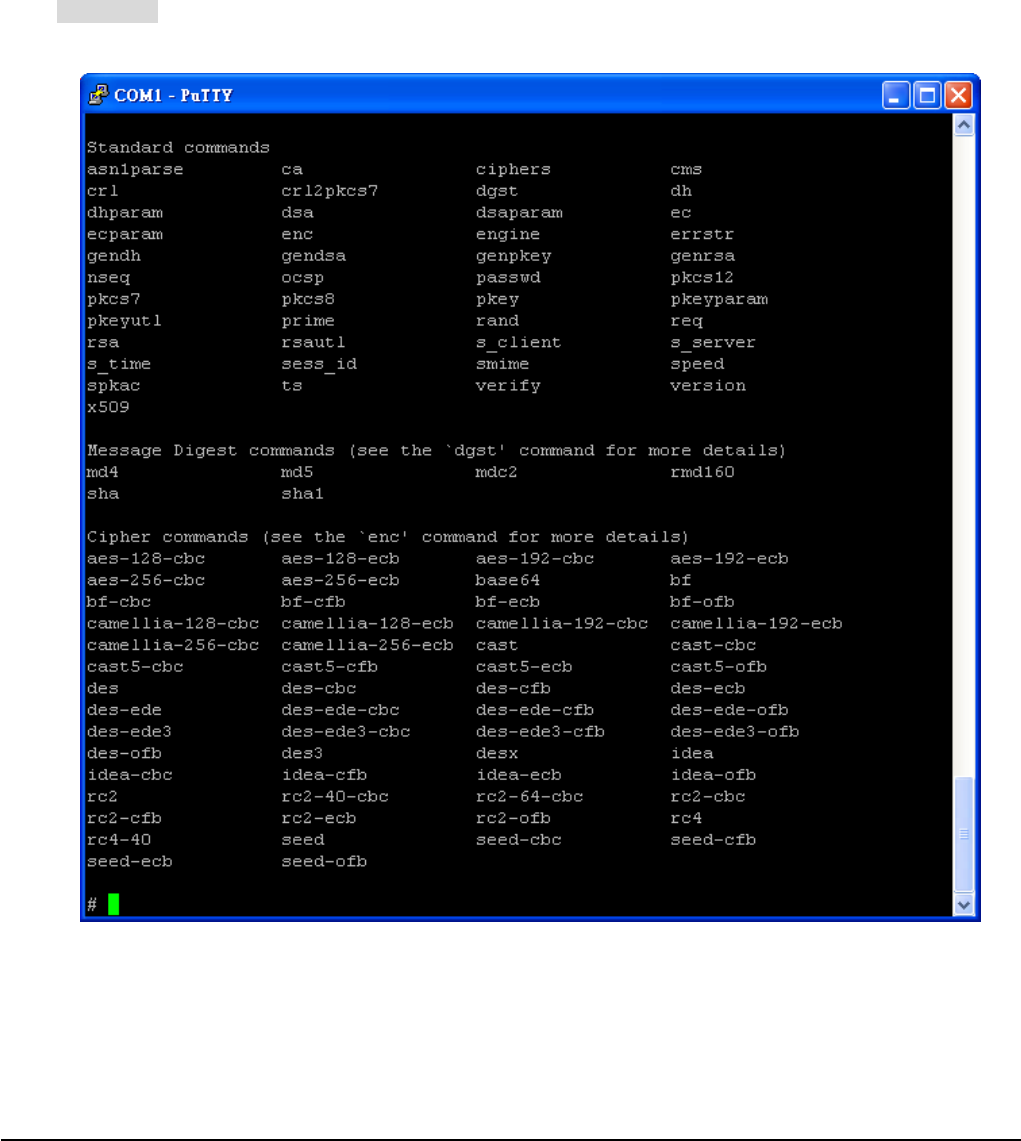
Doc #: 1ANSU-160004
DNI SGDC-D22 User Manual
i. 28
7.7. SSL
OpenSSL is used to encrypt and decrypt on different algorithm for different purpose.
You can use the command to check what kind of command and algorithm are supported.
# openssl –h
Figure 21, OpenSSL commands and algorithms supported.

Doc #: 1ANSU-160004
DNI SGDC-D22 User Manual
i. 29
7.8. Sendmail via SMTP
Sendmail is used to send a mail via SMTP protocol, the following command is an example to send a mail from DCU
to Gmail SMTP server, and Gmail SMTP server will help you to send the mail to the receiver’s mail server.
Use vi to create an example mail:
# vi /var/mailtest
Subject: This is a mail test
CC: xxxx@gmail.com
To: yyyy@gmail.com
From: zzzz@gmail.com
This is a test
After editing the test mail content, please use the following command to send it out. (Noted: make sure that the DCU
can access Internet.)
# sendmail -f zzzz@gmail.com -v -H 'openssl s_client -connect smtp.gmail.com:465 -quiet' -auUSERNANE
-apPASSWORD < /var/mailtest

Doc #: 1ANSU-160004
DNI SGDC-D22 User Manual
i. 30
8. I/O Control
8.1. Data Collector ID
To get DCU id, execute the following command.
# getuid
8.2. System Ready LED
To get turn on or turn off the ready led, execute the following command.
# sysrd-led-on
# sysrd-led-off
8.3. Buzzer
To control the buzzer, execute the following command with the unit in millisecond.
# buzzer <msec>
8.4. Reset Button
The action of the reset button is programmable. The default action is:
< 5 seconds: Reset the device.
> 5 seconds: Recovery to the default settings.
8.5. RS-232 & RS-485
RS-232 port is mapped to the Linux device /dev/ttyM0, and RS485 is /dev/ttyM1. RS-485 can support 2-wire and
4-wire mode, you need to select the correct mode before you use it. To select the RS-485 mode, execute the following
command.
2-wire mode:
# setport 1
4-wire mode:
# setport 0

Doc #: 1ANSU-160004
DNI SGDC-D22 User Manual
i. 31
8.6. SD Card
SD card is designed to be mounted automatically. When a SD card is inserted into the SD card slot, there will be
directory on /var/sd. The mount point will be removed when the SD card is removed.
8.7. Combine WDT Into Your Program
DNI data collector provides a watchdog timer which has a 32- bit down counter with a programmable timeout value.
On timeout it generates an interrupt and reset signal. The WDT is intended to be used to generate a system reset if a
software failure (or a system hang) occurs. The WDT driver provides a set of ioctls to the user. Through this interface
user can configure, program and refresh the WDT. The device node of WDT is /dev/watchdog. The following code
snippets demonstrate how to use the WDT.
To open the WDT interface:
char wdt_dev[] = "/dev/watchdog"
int fd;
fd = open(wdt_dev, O_RDWR);
if (fd < 0) {
printf("Error in opening device\n");
}
To control the WDT and set the timeout as 45 seconds:
int ret = 0;
int timeleft=0;
struct watchdog_info ident;
int timeout = 45; /* in seconds */
/* to find out supported options in watchdog */
ret = ioctl(fd, WDIOC_GETSUPPORT, &ident);
/* to set time out */
ioctl(fd, WDIOC_SETTIMEOUT, &timeout);
/* to find out how much time is left before reset */
ret = ioctl(fd, WDIOC_GETTIMEOUT, &timeleft);
/* Refresh watchdog timer at every 10 secs to prevent reset */
while (1) {
ioctl(fd, WDIOC,KEEPALIVE, 0);
sleep(10);
}

Doc #: 1ANSU-160004
DNI SGDC-D22 User Manual
i. 32
The WDT interface IOCTL options:
IOCTL Code
Usages
WDIOC_GETSUPPORT
The fields returned in the ident structure are:
identity: A string identifying the watchdog driver firmware_version: the firmware
version of the card if available.
options: A flags describing what the device supports.
WDIOC_KEEPALIVE
This ioctl does exactly the same thing as a write to the watchdog device and hence
refreshes the timer
WDIOC_SETTIMEOUT
Set time out in seconds, after which reset would be generated (if WDT is not
refreshed)
WDIOC_GETTIMEOUT
Query the current timeout
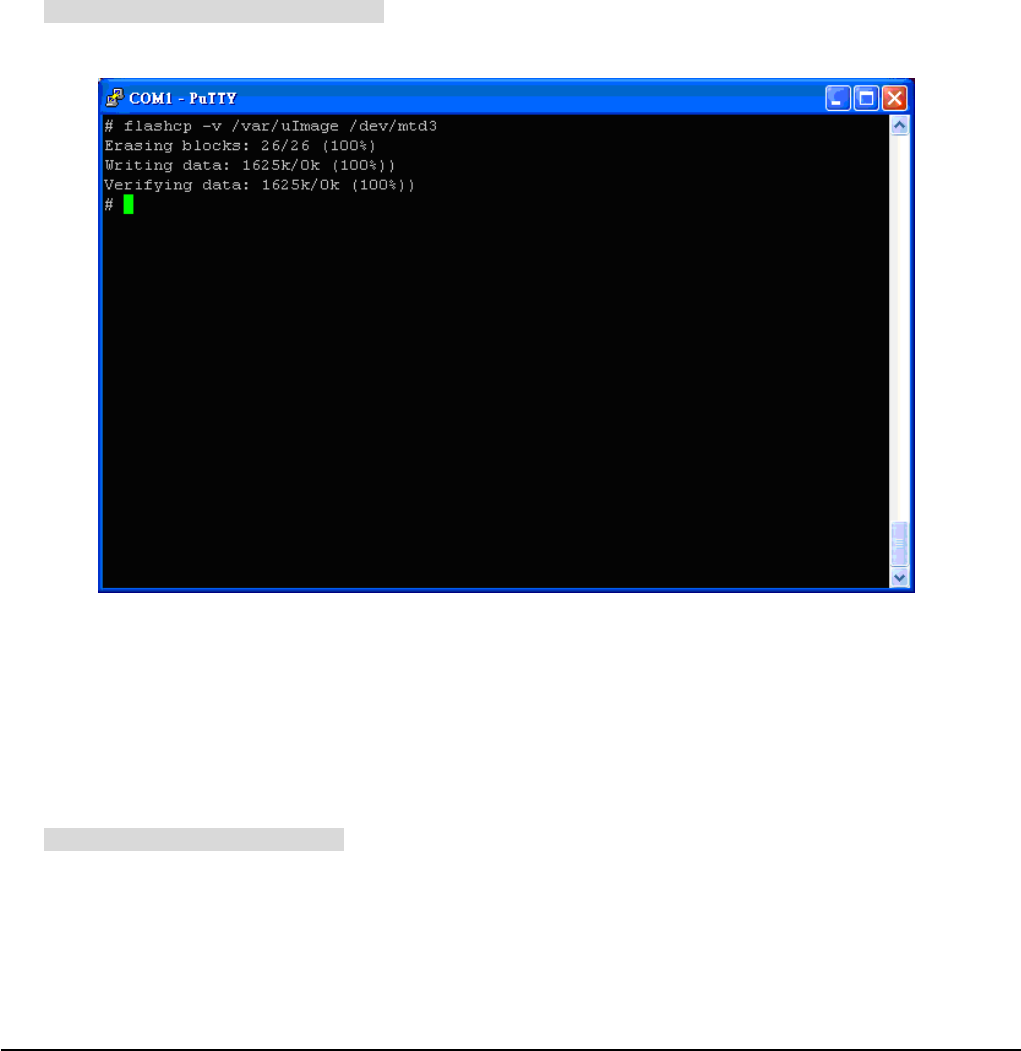
Doc #: 1ANSU-160004
DNI SGDC-D22 User Manual
i. 33
9. Linux Kernel Upgrade & Backup
Upgrade:
Use FTP or SCP to put your kernel image into the device directory /var and execute the following command on the
device to upgrade the kernel image.
# flashcp –v /var/<imagename> /dev/mtd3
Figure 22, Upgrade Linux kernel image.
When it is done, please reboot your device to apply the kernel image you upgraded.
Backup:
Execute the following command to backup the current kernel image on the device to the /var directory.
# dd if=/dev/mtd3 of=/var/kernel.img
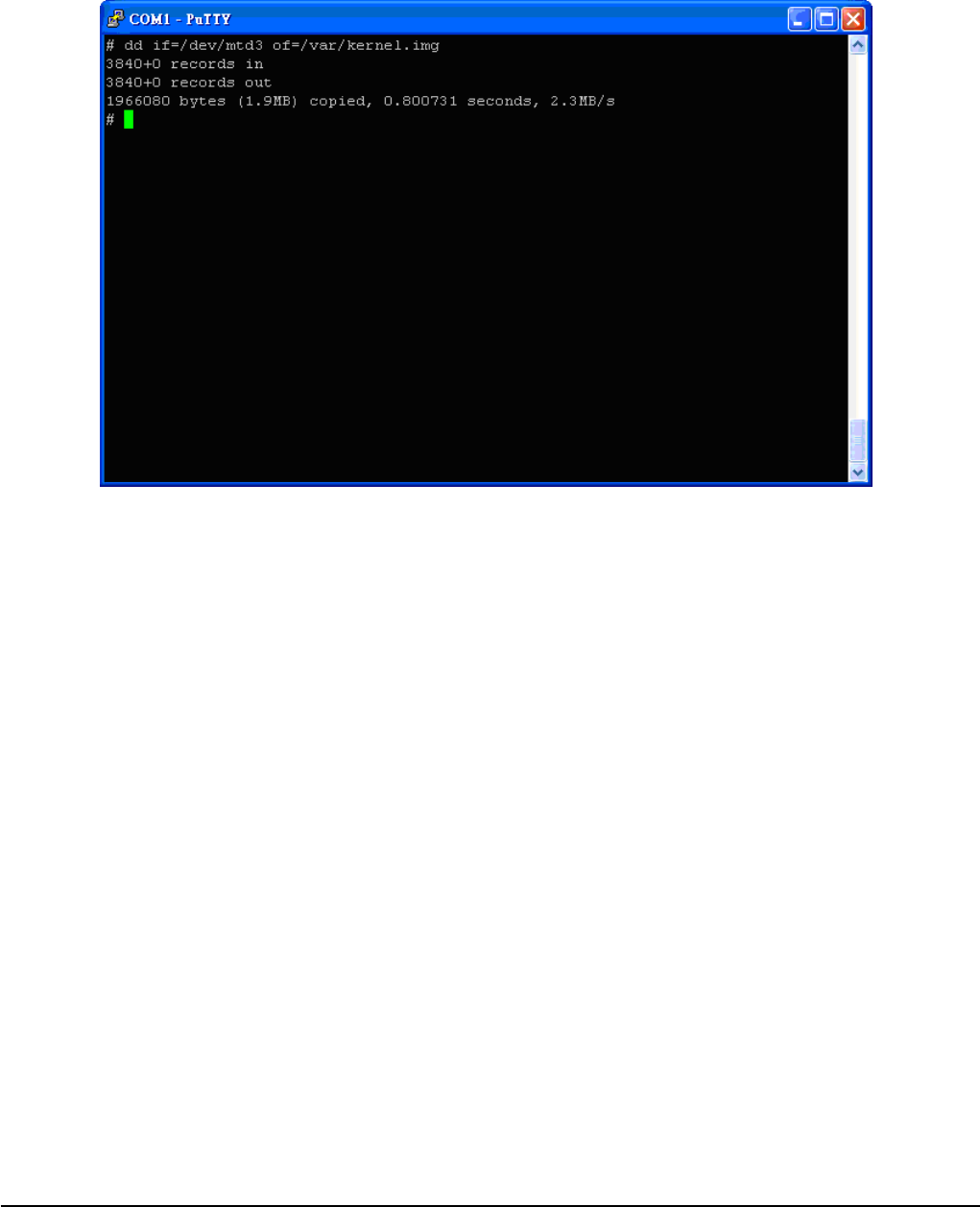
Doc #: 1ANSU-160004
DNI SGDC-D22 User Manual
i. 34
Figure 23, Backup Linux kernel image from DCU.
When it is done, you can restore the kernel.img via FTP or SCP to your remote computer.
